
A Quick Start Guide to Walk-In Cooler Temperature Alarms
Protecting Your Critical Storage: Why Walk-In Cooler Temperature Alarms Are Essential
Walk in cooler temperature alarms are essential monitoring systems that protect valuable inventory by alerting you when temperatures exceed safe thresholds. Here's what you need to know:
- Purpose: Prevents costly product loss by monitoring temperatures 24/7
- Types: Wired (hardwired to building systems) or wireless (WiFi, Bluetooth, cellular)
- Key features: Temperature sensors, customizable alerts (SMS/email/app), data logging
- Price range: $100-$1,500+ depending on features and connectivity options
- Recommended brands: Modularm 75LC, Sensaphone Sentinel, Monnit ALTA, VersaTile WiFi
A single walk-in cooler failure can result in losses exceeding $5,000 in spoiled inventory if not detected promptly. Modern temperature alarm systems eliminate manual monitoring, automatically log data for compliance, and provide instant notifications when problems occur.
The FDA requires all refrigerated foods to be stored at 40°F (4°C) or lower, with most commercial refrigerators maintained at 38°F (3.3°C) to provide a safety margin. For walk-in freezers, temperatures should be set at or below 0°F (-18°C).
Temperature alarms aren't just convenient—they're essential protection against equipment failures, power outages, and human error that could otherwise go undetected until significant damage occurs.
I'm Mortuary Cooler, a national-level supplier of mortuary coolers and walk-in systems with extensive experience implementing walk in cooler temperature alarm solutions for funeral homes and medical facilities across the country. My team has helped hundreds of businesses protect their sensitive inventory with reliable monitoring systems custom to their specific needs.
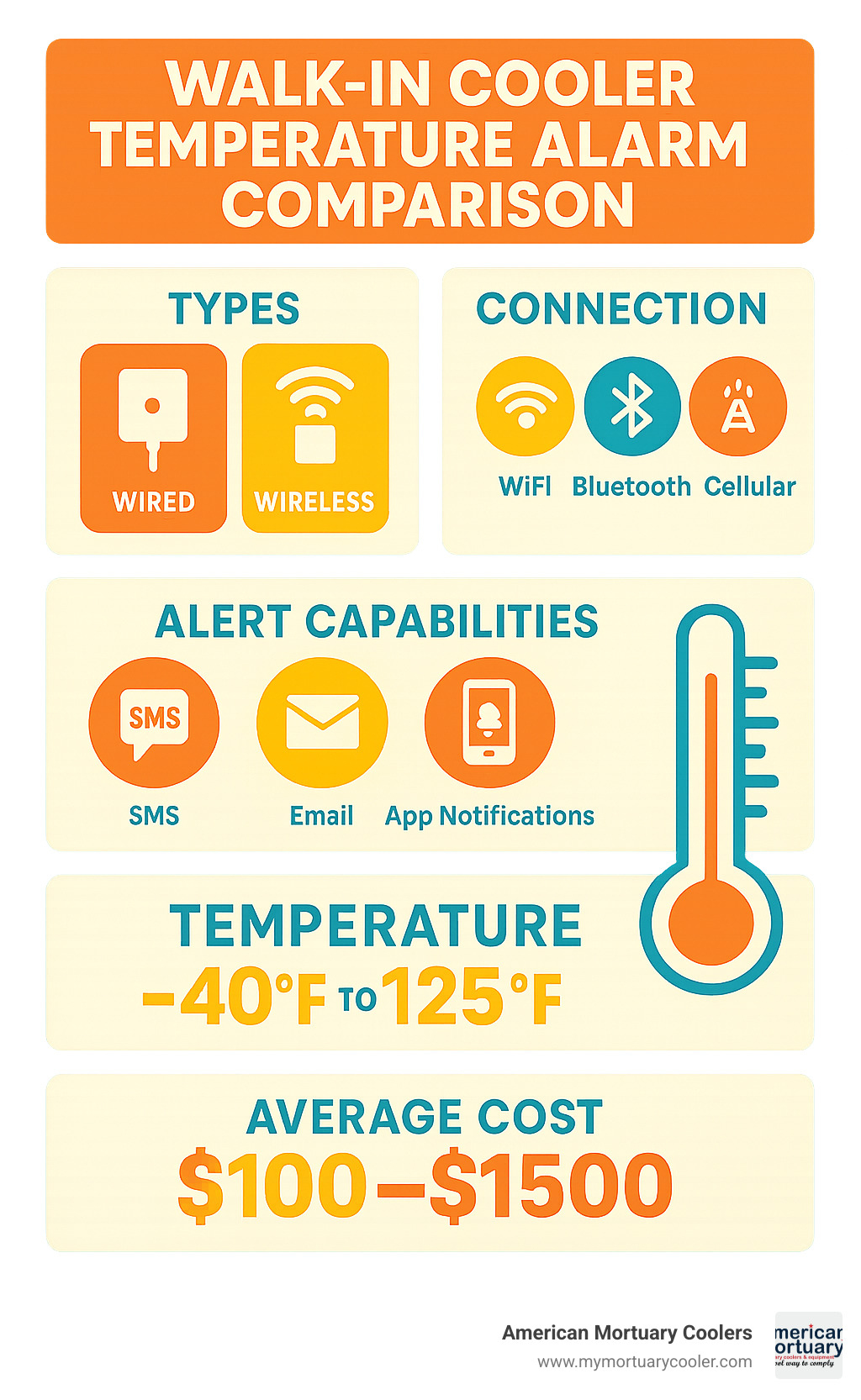
Why Monitoring Matters Before an Alarm Sounds
Temperature monitoring isn't just about preventing spoilage—it's about protecting your business from regulatory penalties, reputation damage, and financial losses. After helping hundreds of clients implement effective monitoring solutions, we've seen how proper temperature control can make or break an operation.
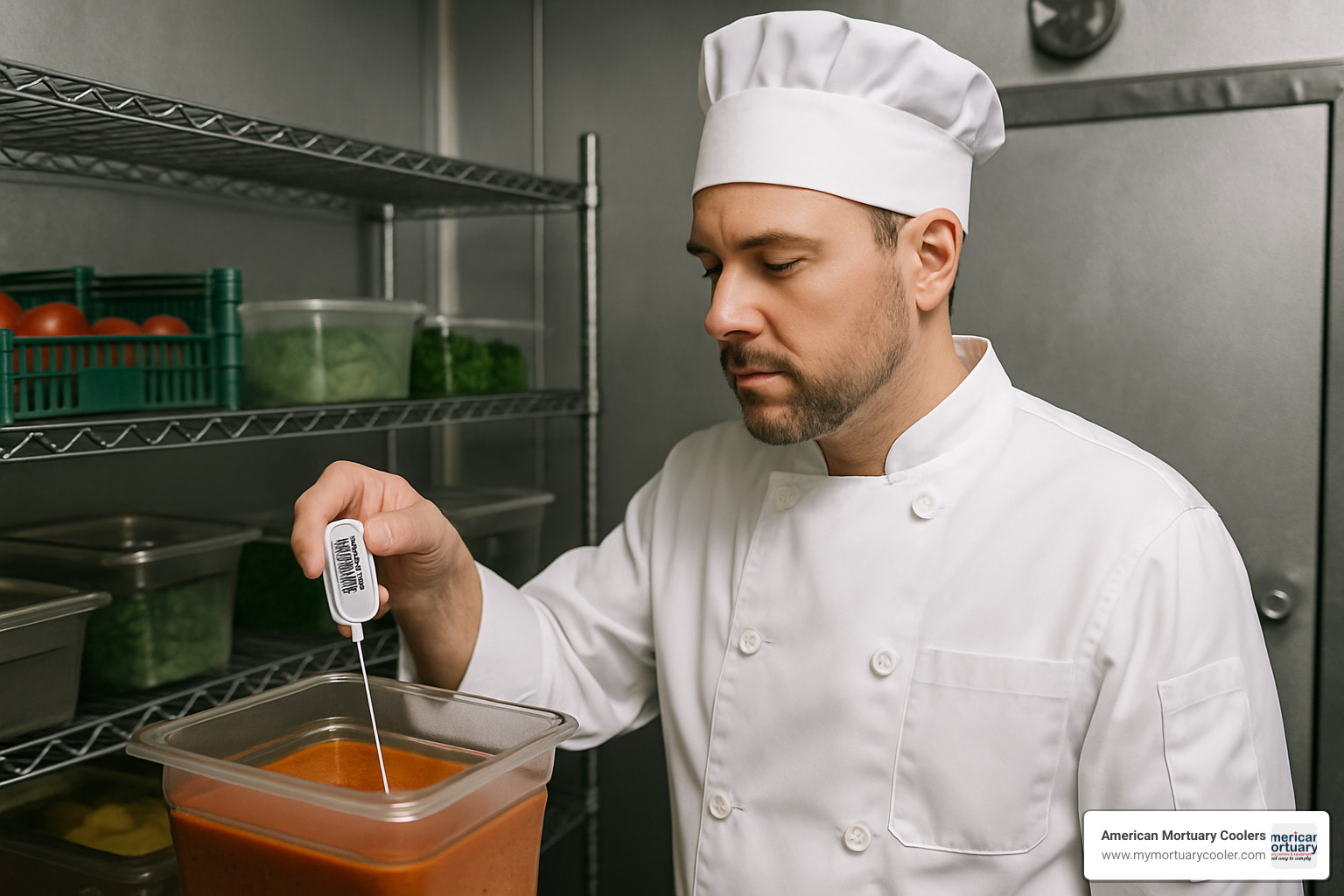
The FDA's 40°F rule exists for a good reason—it's the critical threshold below which bacterial growth significantly slows. When temperatures creep above this point, the clock starts ticking on your inventory's safety. According to industry data, the average loss from a single cooler failure exceeds $5,000, but we've witnessed cases where losses climbed much higher for facilities with specialized or high-value inventory.
Manual temperature checks might seem sufficient, but they introduce serious vulnerabilities. Staff members forget to check, readings get recorded incorrectly, and worst of all—no one's monitoring during nights, weekends, or holidays when failures often occur. That's precisely when automated walk in cooler temperature alarm systems prove their worth by providing round-the-clock monitoring, instant alerts, and tamper-proof records that satisfy even the strictest inspectors.
As the FDA research on food safety thermometers confirms, consistent temperature monitoring is essential for safety, not just a nice-to-have feature.
Risks of Skipping a Walk-In Cooler Temperature Alarm
The danger zone between 40°F and 140°F (4°C to 60°C) is where bacteria multiply rapidly—potentially doubling every 20 minutes. Without a reliable temperature alarm system, you're essentially gambling with:
Your valuable inventory can be wiped out overnight if temperatures rise undetected. One of our clients in Atlanta learned this lesson the hard way when a compressor failed over a long weekend. Without alerts, they lost over $12,000 in inventory and faced a health department investigation. After installing our recommended walk in cooler temperature alarm system, they've caught three potential failures before any loss occurred.
Beyond the immediate financial hit, regulatory violations can lead to fines, increased scrutiny, and even temporary closure. And in today's connected world, reputation damage spreads quickly—one incident of compromised products can haunt your business for years.
Recommended Temperature Ranges & Logging Frequency
While requirements vary slightly across industries, these guidelines apply to most walk-in applications:
| Storage Type | Recommended Temperature | FDA Requirement | Healthcare Standard |
|---|---|---|---|
| Walk-in Cooler | 36°F to 38°F (2°C to 3.3°C) | Below 40°F (4°C) | 36°F to 46°F (2°C to 8°C) |
| Walk-in Freezer | -10°F to 0°F (-23°C to -18°C) | At or below 0°F (-18°C) | Below -4°F (-20°C) |
The frequency of temperature logging varies by industry needs. Food service operations typically require checks at least twice daily, while healthcare and pharmaceutical facilities often need hourly or continuous monitoring. Research laboratories and mortuary services generally require continuous monitoring with immediate alerts for any deviation.
HACCP compliance isn't just about maintaining proper temperatures—it's about proving you did so with consistent documentation. Modern walk in cooler temperature alarm systems create automatic, tamper-proof records that satisfy regulatory requirements without the hassle of manual logs.
For facilities storing sensitive materials, the peace of mind that comes from knowing you'll be alerted to problems before they become disasters is truly invaluable. As one funeral director told us after installing our system, "I finally sleep through the night without worrying about what I might find in the morning."
How Walk-In Cooler Temperature Alarms Work & Must-Have Features
Ever wondered what's actually happening inside those little boxes keeping watch over your coolers? Let me break it down for you. All walk in cooler temperature alarms have three main parts working together to protect your valuable inventory:
- Sensor Probes: These clever little devices sit inside your cooler, constantly taking temperature readings. Think of them as your 24/7 vigilant employees who never need coffee breaks!
- Control Unit: This is the system's brain, processing all those temperature readings and deciding when something's not right.
- Notification System: When temperatures drift where they shouldn't, this is what gives you a heads-up – whether through a loud alarm, a text message, or an email that essentially says, "Houston, we have a problem."
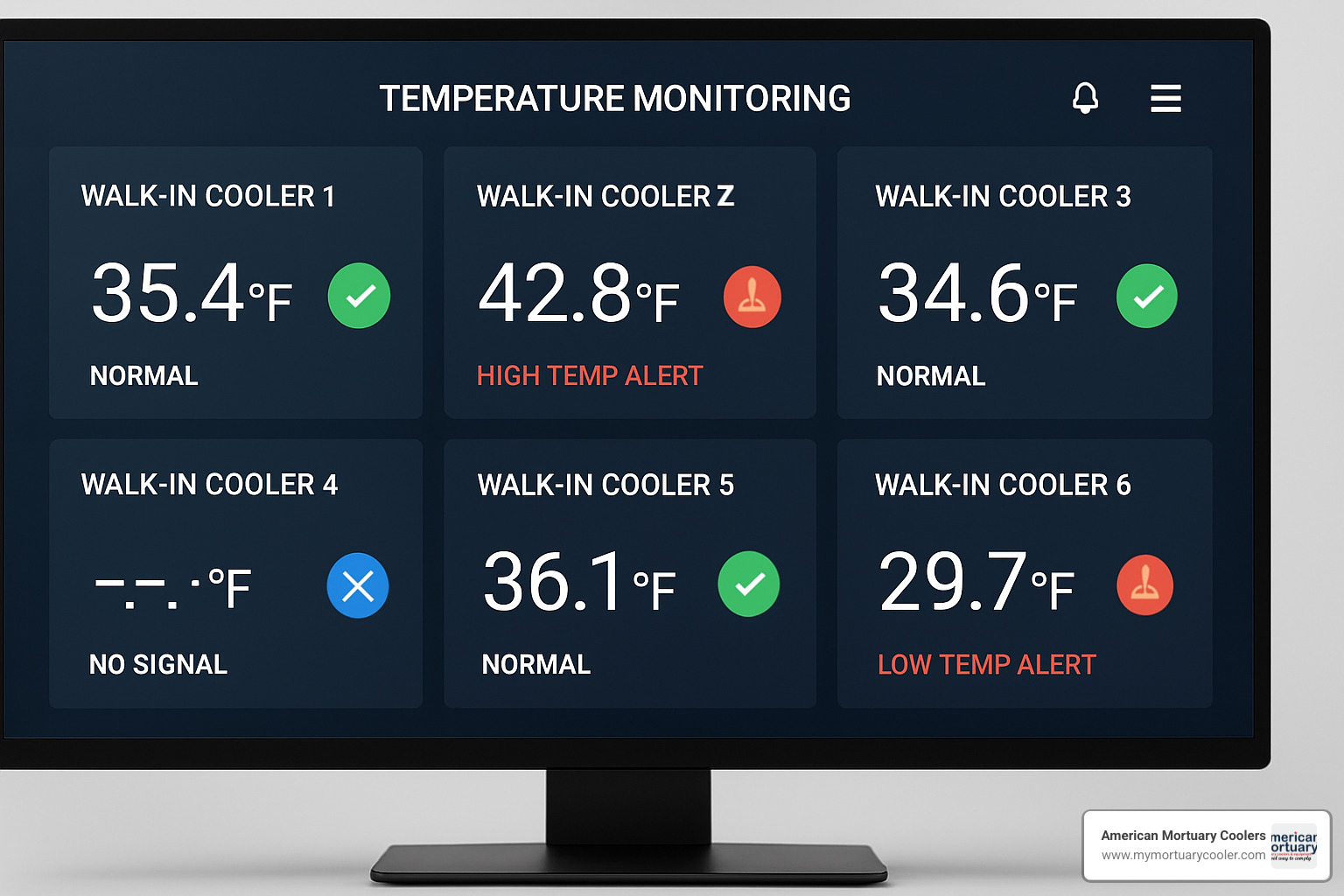
Today's systems have come a long way from the simple thermostats of yesteryear. Modern walk in cooler temperature alarms offer sleek cloud dashboards you can check from your phone while sipping coffee at home. They're multitaskers too – monitoring not just temperature but also tracking if someone left the door open (again!), whether your power is working, humidity levels, and even how your compressor is performing.
A quality system will include battery backup – absolutely crucial for those moments when storms knock out power and you're wondering if thousands of dollars of inventory is slowly warming to the danger zone.
Connectivity Showdown: Wired vs. Wireless Systems
Choosing between wired and wireless is a bit like deciding between buying or renting – each has its place depending on your situation.
Wired Systems are the reliable old-timers of the monitoring world. They're always on duty and never need battery changes. They're often integrated with your building's management system, creating a seamless monitoring experience. The downside? Installation can be pricey and once they're in, they're not exactly portable. They're perfect for new buildings or permanent setups where reliability trumps flexibility.
Wireless Systems are the new kids on the block – easy to install (sometimes literally in minutes), flexible to place anywhere, and often gentler on your wallet upfront. The trade-offs? You'll be changing batteries periodically, and they're somewhat dependent on good signal strength. They're ideal for existing buildings where running wires would be a nightmare or for businesses that might need to relocate equipment.
Wireless systems typically communicate in one of three ways:
Wi-Fi systems piggyback on your existing network – convenient but dependent on your network's reliability. Bluetooth options offer excellent local monitoring but with limited range. Cellular systems are the independent spirits, working regardless of your local infrastructure, though they often come with subscription fees.
The smartest systems actually use multiple methods as backup. I've seen many operations saved when their Wi-Fi went down, but the cellular backup kicked in seamlessly.
One feature worth its weight in gold is defrost cycle filtering – the system's ability to recognize when temperature increases are just part of a normal defrost cycle rather than a true emergency. This prevents those middle-of-the-night false alarms that have you rushing to the facility in your pajamas!
Key Features Checklist for Your Walk-In Cooler Temperature Alarm
When shopping for a walk in cooler temperature alarm, here's what the best systems should offer:
Adjustable setpoints let you customize exactly when alarms trigger based on your specific needs. Multiple alert methods ensure you're notified whether you prefer texts, emails, phone calls, or app notifications. Data logging capabilities automatically create the records you need for compliance, while remote access lets you check on things from anywhere with an internet connection.
Battery backup is non-negotiable for serious protection, while multiple sensor support allows monitoring different zones within the same cooler. Door monitoring alerts you when someone leaves the door ajar, and power monitoring notifies you of outages immediately.
Calibration features ensure your system stays accurate over time – critical for regulatory compliance. Speaking of which, if you're in healthcare or pharmaceuticals, look for systems that are CFR 21 Part 11 compliant, which includes proper electronic records with appropriate security controls.
For those wanting to dive deeper into selection criteria, there's more detailed information available about Selecting the Best Walk-In Cooler System on our website.
At American Mortuary Coolers, we've helped countless funeral homes and medical facilities select the right monitoring systems for their specific needs – because we understand that when it comes to temperature monitoring, one size definitely doesn't fit all!
Product Roundup: Best Walk-In Cooler Temperature Alarm Systems
I've personally tested dozens of systems and our team has installed hundreds for clients nationwide. After all this hands-on experience, I've put together this honest breakdown of the best walk in cooler temperature alarm systems available today. These are the systems I'd recommend to my own family if they were in your shoes.
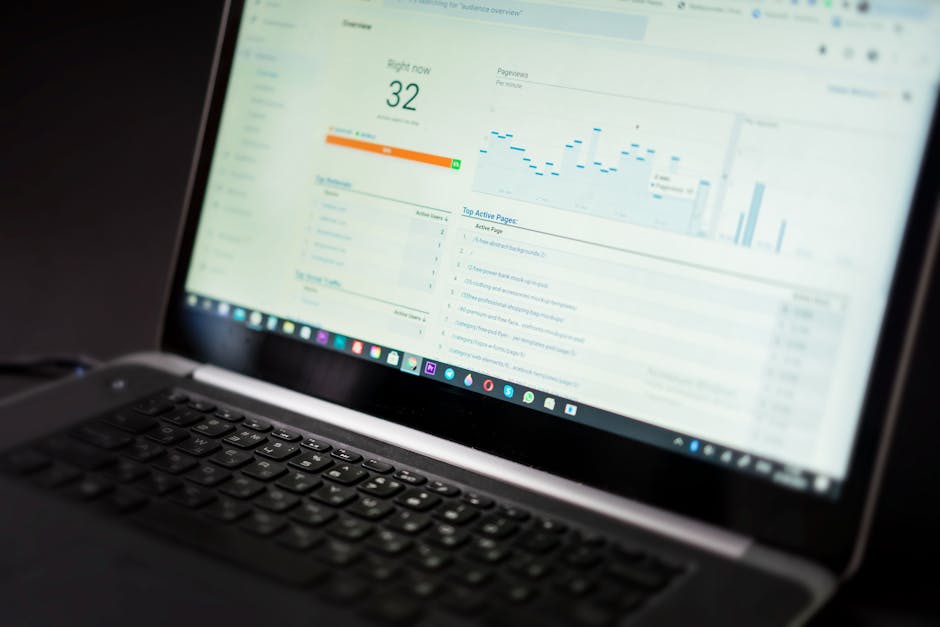
Budget Pick – ThermAlarm Basic
Price Range: $100-$200
If you're watching your budget but still need reliable protection, the ThermAlarm Basic is your friend. It's refreshingly straightforward – no complicated bells and whistles, just dependable temperature monitoring that gets the job done.
This little workhorse was actually designed for greenhouses originally, but small funeral homes and businesses have acceptd it for its simplicity and reliability. It gives you a clear display, a good loud alarm when temperatures drift, and even offers an optional phone dialer to notify you remotely.
What I love about this system is there are no subscription fees to worry about, and installation is something most folks can handle themselves in under an hour. One of our clients in Columbia – a small family-run funeral home – has used their ThermAlarm Basic for over five years without a hiccup. For single-cooler operations with basic needs, it's an excellent value.
The only downsides? No data logging for compliance records and limited remote capabilities. You'll need to manually calibrate it occasionally too.
Mid-Range Winner – VersaTile Remote Wi-Fi Walk-In Cooler Temperature Alarm
Price Range: $200-$400
The VersaTile system hits that sweet spot between affordable and feature-rich. It's our most popular recommendation for mid-sized operations because it delivers impressive functionality without breaking the bank.
What makes the VersaTile special is its Wi-Fi connectivity that lets you monitor temperatures from anywhere. It tracks conditions from a frigid -65°F all the way up to 257°F, and will instantly alert up to 10 people via text or email if something goes wrong. The battery life is exceptional – over a year on just two AA lithium batteries – though most clients opt for the USB-C continuous power option for extra peace of mind.
I particularly appreciate that it includes HACCP-compliant data logging right out of the box. The mobile app and web dashboard are intuitive enough that even the most tech-resistant owners can steer them with ease.
A restaurant owner in Dallas told me, "It paid for itself the first month when it alerted us to a failing compressor before we lost any product." That's exactly why we recommend this system so often – it prevents disasters before they happen.
Just be aware that you'll need stable Wi-Fi, and some of the more advanced features require a premium subscription after the first year.
Enterprise Choice – Monnit ALTA AC & Temperature Suite
Price Range: $500-$1,500+
For larger operations with multiple monitoring points and strict compliance requirements, the Monnit ALTA system is worth every penny. This is enterprise-grade monitoring that still manages to be user-friendly.
The battery life on these sensors is nothing short of remarkable – up to 10 years in some cases. The wireless range is equally impressive at over 2,000 feet, which means you can monitor multiple coolers across a large facility without complicated wiring or signal boosters.
What really sets Monnit apart is versatility. With support for over 80 different sensor types, you can monitor temperature, humidity, door status, power, water presence, and dozens of other conditions all from the same dashboard. The system is fully CFR 21 Part 11 compliant, making it perfect for healthcare facilities and research labs.
We recently implemented Monnit systems for a regional funeral home chain with locations throughout the Southeast. The operations manager can now monitor every cooler in every location from a single dashboard, while still allowing local staff appropriate access levels. The reporting features make compliance in a few clicks with our reports section.
The only real drawbacks are the higher initial investment and slightly more complex setup, plus the subscription fees for advanced features. But for multi-location businesses, the centralized monitoring is invaluable.
Specialty Pick – Modularm 75LC Multi-Monitor for Door & Panic Protection
Price Range: $300-$600
The Modularm 75LC goes beyond simple temperature monitoring to address a critical safety concern – staff who work inside walk-in coolers. This system combines precise temperature monitoring with potentially life-saving features.
Its patented Autoset™ technology automatically adjusts setpoints based on normal operating conditions, which reduces false alarms while still catching genuine problems. Temperature accuracy is impressive at ±1°F across the critical range from -25°F to 70°F.
What makes this system special is the integrated panic button and door monitoring. If a staff member becomes trapped inside a walk-in, they can trigger an immediate alarm. The door-ajar detection also prevents both energy waste and temperature fluctuations from doors left open accidentally.
A hospital client in the Northeast credits this system with potentially saving a staff member who became trapped in a walk-in freezer during an overnight shift. For facilities where staff regularly enter walk-ins, these safety features aren't just nice to have – they're essential.
The only downside is installation complexity – this typically requires professional setup to ensure all safety features function properly.
Cellular Hero – Sensaphone Sentinel 1200
Price Range: $800-$1,500
For locations with unreliable internet or those requiring the ultimate in connectivity redundancy, the Sensaphone Sentinel 1200 is my go-to recommendation. This rugged system uses 4G cellular networks instead of Wi-Fi, ensuring monitoring continues even when internet service fails.
The NEMA 4X weatherproof enclosure means it can be installed almost anywhere, and I particularly value the multiple notification methods – not just texts and emails, but actual voice calls for truly urgent situations. The remote system reboot capability has saved many clients from having to make middle-of-the-night trips to their facility.
We installed a Sensaphone system for a research facility in the Rocky Mountains where internet connectivity was spotty at best. The peace of mind knowing their irreplaceable samples were being monitored 24/7, regardless of local internet conditions, was well worth the investment.
The cellular subscription does add to the ongoing costs, and the initial investment is higher than Wi-Fi-based systems. But for critical applications where monitoring absolutely cannot fail, it's the most reliable option available.
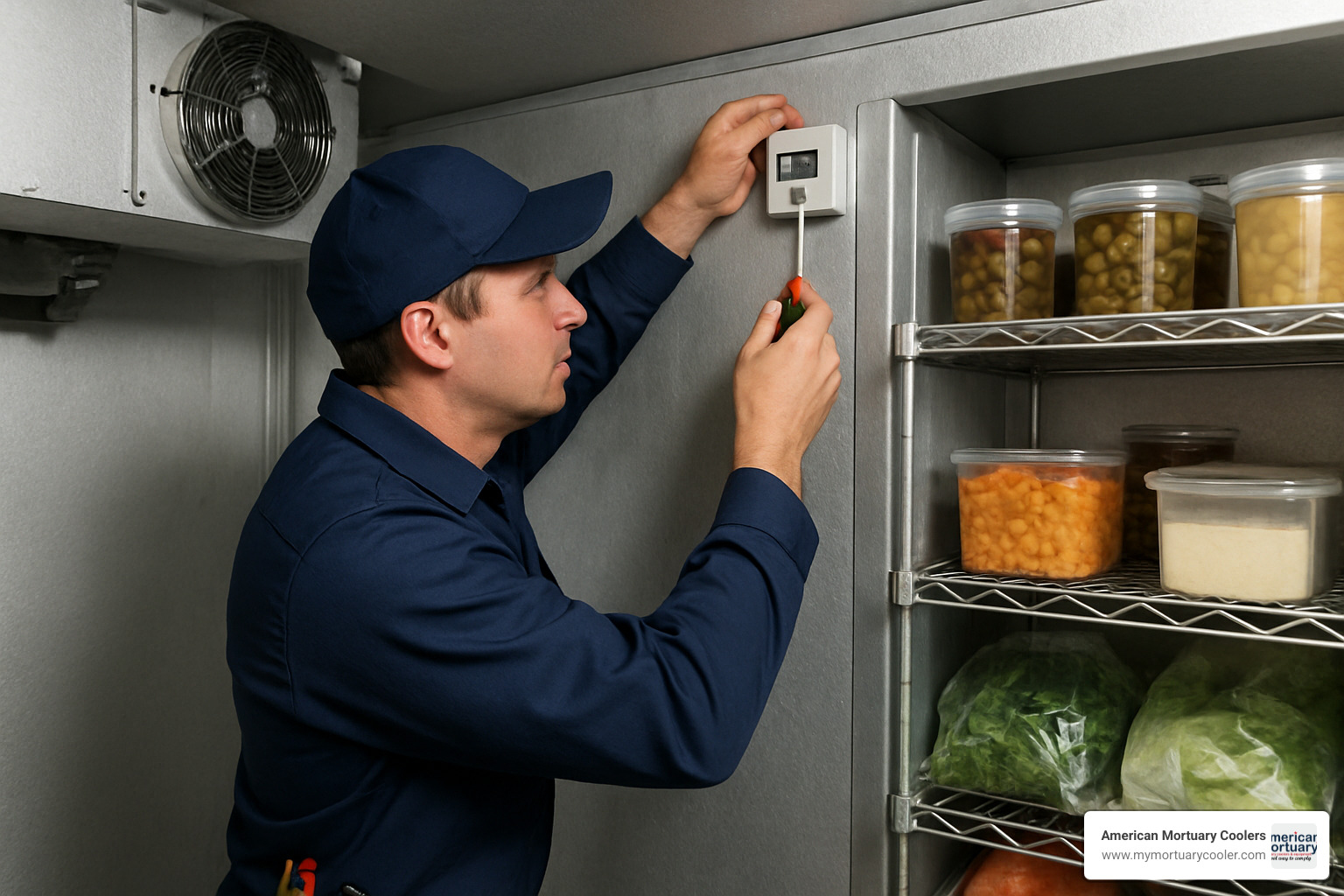
Choosing the Right Walk-In Cooler Temperature Alarm for Your Operation
Selecting the appropriate walk in cooler temperature alarm system requires a thoughtful assessment of your specific needs. Here's our recommended approach:
-
Assess Your Requirements:
- How many coolers/freezers need monitoring?
- What temperature ranges must you maintain?
- What are your industry's compliance requirements?
- How critical is your inventory (value, replaceability)?
-
Evaluate Your Environment:
- What connectivity options are available (Wi-Fi, cellular coverage)?
- Are there physical installation constraints?
- What is your power reliability situation?
- Do you need to monitor multiple parameters (temperature, humidity, door status)?
-
Consider Your Budget:
- Initial equipment costs
- Installation expenses
- Ongoing subscription fees
- Potential ROI from prevented losses
-
Plan for Growth:
- Scalability for additional units
- Future compliance requirements
- Technology obsolescence
We offer a free ROI calculator to our clients that helps quantify the value of a temperature monitoring system based on inventory value, replacement costs, and historical failure rates. In most cases, even premium systems pay for themselves within the first year through prevented losses and reduced manual monitoring labor.
Manual Logs vs. Automated Alerts: Pros & Cons
Many facilities still rely on manual temperature logging, but this approach has significant limitations compared to automated systems:
Manual Logging Pros:
- Lower initial investment
- No technology dependencies
- Simple staff training
Manual Logging Cons:
- Labor intensive (costs approximately $5,000-$8,000 annually in staff time)
- Prone to human error and falsification
- Limited to business hours
- Delayed response to problems
- Difficult to analyze trends
- May not satisfy stricter regulatory requirements
Automated Monitoring Pros:
- 24/7 continuous monitoring
- Immediate alerts when issues arise
- Comprehensive, tamper-proof record-keeping
- Trend analysis capabilities
- Reduced labor costs
- Improved compliance capabilities
Automated Monitoring Cons:
- Higher initial investment
- Technology dependencies
- May require subscription fees
- Staff training for system management
Common manual monitoring errors include:
- Missed checks during busy periods
- Incorrect readings or recording errors
- "Pencil whipping" (filling in logs without actual checks)
- Failure to identify gradual temperature trends
- Inconsistent documentation formats
Clients using Sonicu's automated temperature monitoring systems average about $80,000 of savings for every 100 hospital beds by eliminating manual logging and reducing asset loss—a compelling case for automation in larger facilities.
Handling Power & Connectivity Failures Gracefully
A robust walk in cooler temperature alarm system must continue functioning even when primary systems fail. Here's how the best systems handle these challenges:
Power Failures:
- Battery backup for monitoring equipment (typically 24-72 hours)
- Immediate power loss notification
- Data buffering to maintain records during outages
- Automatic resumption when power returns
Connectivity Failures:
- Cellular failover for Wi-Fi-based systems
- Local audible alarms as backup
- Data storage during connectivity gaps
- Automatic synchronization when connection restores
Physical Considerations:
- A well-insulated walk-in freezer can maintain safe temperatures for 24-48 hours if doors remain closed
- Using dry ice or alternative cooling during extended outages
- Prioritizing inventory movement based on value and sensitivity
One of our clients in the Pittsburgh area experienced a 36-hour power outage during a severe winter storm. Their Monnit system with cellular backup continued monitoring throughout the outage, allowing them to track temperature rise and make informed decisions about inventory protection. The system's alerts enabled them to deploy generators before temperatures reached critical thresholds, saving over $50,000 in inventory.
Frequently Asked Questions about Walk-In Cooler Temperature Alarm Systems
How often should I calibrate my sensors?
One question I hear all the time from clients is about calibration frequency. For most walk-in coolers, I recommend a quarterly check of your temperature sensors. This schedule strikes that perfect balance between maintenance effort and ensuring accuracy.
If you're in healthcare or pharmaceutical storage, you might want to bump this up to monthly checks – better safe than sorry when it comes to sensitive inventory!
The calibration process itself is straightforward but crucial. You'll compare your system's readings against a certified reference thermometer (ideally one with NIST-traceable certification), adjust any offset values in your system's software, and document everything for those inevitable compliance checks.
I remember helping a client in Memphis who skipped calibrations for almost a year – their sensors had drifted nearly 7 degrees without them realizing it! Thankfully, we caught it before any inventory was compromised, but it was a close call.
For regulated industries like healthcare, professional third-party calibration services are often required. At American Mortuary Coolers, we're happy to connect you with trusted calibration partners who understand the unique needs of temperature-sensitive environments.
Do alarms ignore defrost cycles?
This is such an important question! Nothing's more frustrating than being woken up at 2 AM by a false alarm during a normal defrost cycle.
Quality walk in cooler temperature alarm systems include smart features to prevent these nuisance alerts. The better systems use a combination of:
- Programmable delay features that temporarily adjust thresholds during scheduled defrost periods
- Sophisticated algorithms that can recognize the pattern of your specific equipment's defrost cycles
- Rate-of-change monitoring that looks at how quickly temperatures are changing rather than just absolute numbers
- Smart filters that can distinguish between a brief defrost spike and a genuine cooling problem
When we install systems for our clients, we take the time to observe your specific equipment's defrost patterns and fine-tune these settings accordingly. One funeral home I worked with was getting 3-4 false alarms every night until we properly configured their defrost cycle settings – the relief on the director's face when he realized he could finally get a full night's sleep was priceless!
Are there ongoing subscription fees?
Let's talk about the elephant in the room – ongoing costs. Yes, most modern cloud-connected monitoring systems do involve some subscription fees, but they're generally quite reasonable when you consider the protection they provide.
Here's what you can typically expect:
For basic systems, you're looking at $0-10 per month – perfect for smaller operations with straightforward needs.
Mid-range systems generally run $15-50 monthly, offering more features and monitoring points.
Enterprise-level systems with all the bells and whistles might cost $50-200+ monthly, depending on the number of sensors and complexity.
These subscriptions typically cover cloud platform access, data storage, alert credits (for those SMS and voice notifications), regular software updates, technical support, and cellular connectivity where applicable.
I always work with my clients to find that sweet spot – robust protection without paying for features you'll never use. One client in Nashville was about to sign up for the premium tier until we realized the basic package would cover all their needs, saving them over $1,200 annually!
Many manufacturers offer tiered pricing based on sensor count and features, so we can usually find something that fits your budget comfortably. Even one prevented inventory loss can pay for years of subscription fees!
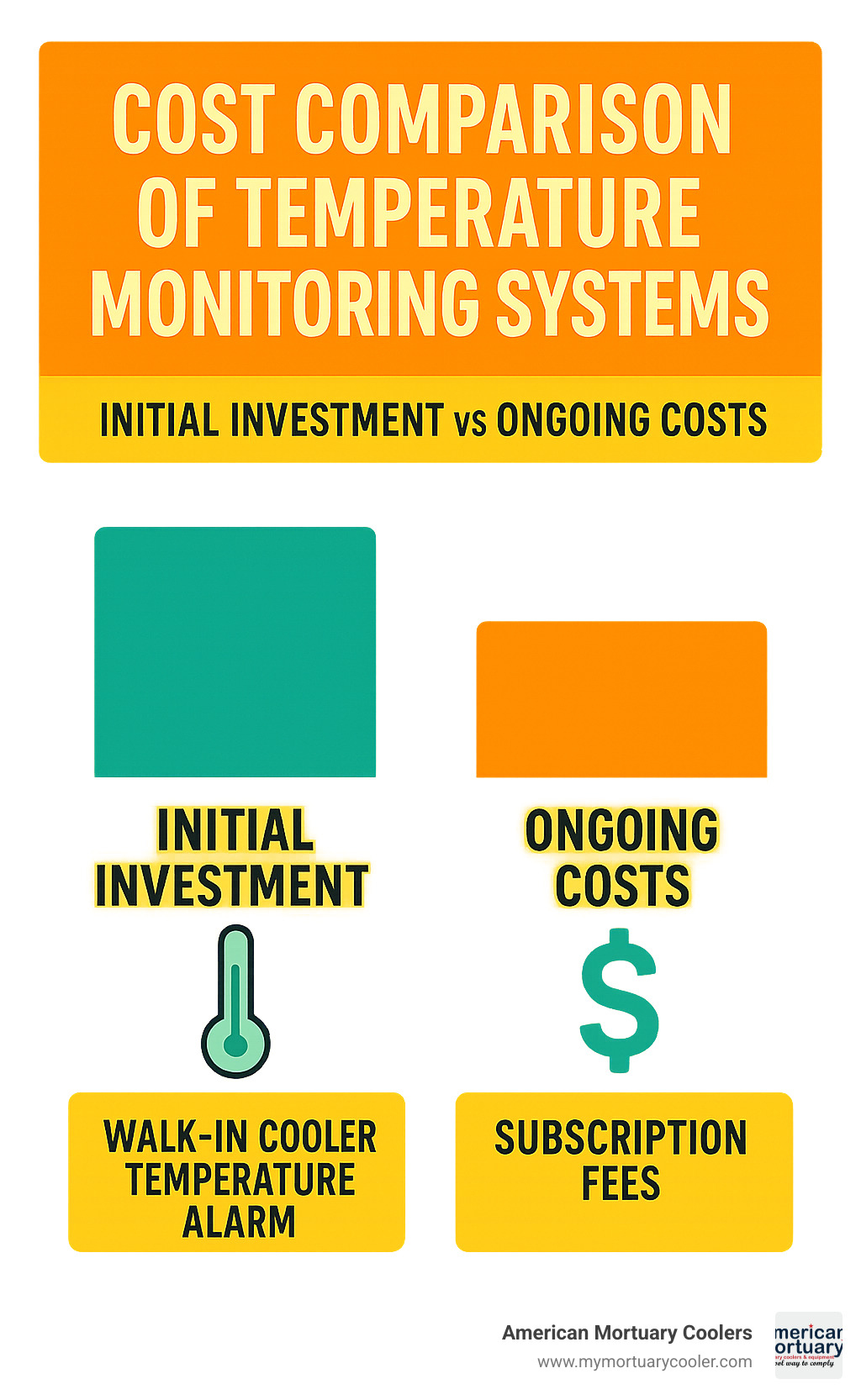
Conclusion
Investing in a reliable walk in cooler temperature alarm system isn't just a box to check for compliance—it's a crucial step in safeguarding your valuable inventory, upholding your reputation, and giving yourself peace of mind. When you consider that a single temperature failure can cost upwards of $5,000 in lost product, these systems quickly pay for themselves.
Here at American Mortuary Coolers, we've seen the relief on our clients' faces when they realize their temperature alarm caught a compressor issue before it became catastrophic. We've specialized in helping funeral homes, medical facilities, and other businesses that depend on precise temperature control find monitoring solutions that truly fit their unique circumstances.
As you move forward with selecting your system, keep these essential considerations in mind:
Think about both your current setup and where you might expand in the future. The monitoring system that works for a single cooler today should be able to grow with you tomorrow. Balance those upfront costs against any ongoing subscription fees—sometimes paying a bit more initially saves you significantly in the long run. Make sure whatever system you choose plays nicely with your existing equipment and infrastructure. For critical applications, redundancy isn't a luxury—it's a necessity. And finally, proper installation isn't the place to cut corners—even the best equipment performs poorly when configured incorrectly.
The world of temperature monitoring continues to evolve rapidly. Today's systems increasingly integrate with broader facility management platforms, offering predictive maintenance alerts and energy efficiency insights that weren't possible just a few years ago. A quality system installed now positions you to take advantage of these innovations as they develop.
Whether you're in Johnson City, Atlanta, Chicago, or anywhere across our nationwide service area, our team is ready to provide personalized guidance on selecting and implementing the perfect walk in cooler temperature alarm system for your specific needs. We're just a phone call away, and we're genuinely committed to helping you protect what matters most.
When it comes to temperature monitoring, an ounce of prevention truly is worth a pound of cure—or in this case, potentially thousands of dollars in saved inventory. Don't wait for a disaster to find just how valuable proper monitoring can be.



